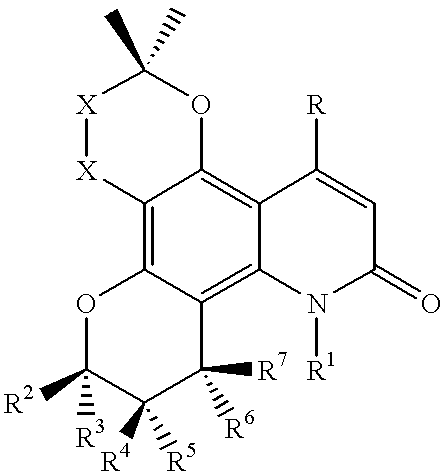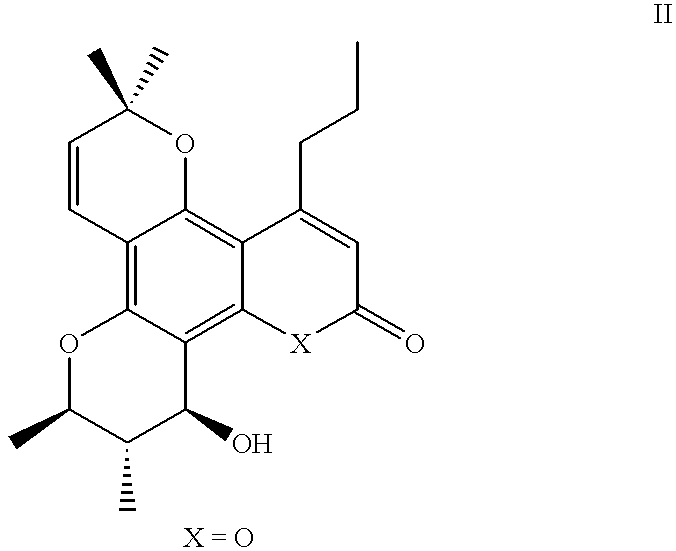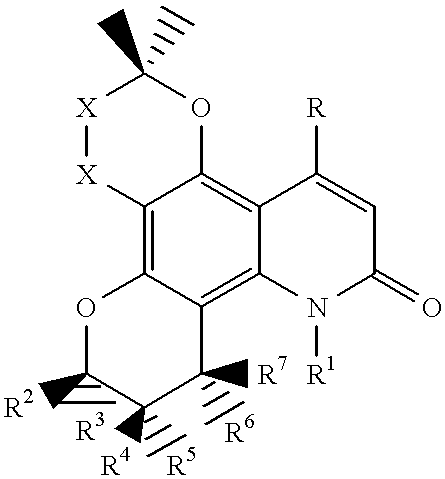Dipyrano-quinolinones useful as anti viral agents and a process for preparing the same
a technology of quinolinones and antiviral agents, which is applied in the field of preparing a process for preparing the same, can solve the problems of poor solubility of this class of compounds in the physiological medium, inability to cure the disease, and difficult scientific endeavor in chemotherapy of aids, and achieves the effect of improving the metabolic stability of compounds
- Summary
- Abstract
- Description
- Claims
- Application Information
AI Technical Summary
Benefits of technology
Problems solved by technology
Method used
Image
Examples
example 2
Preparation of (.+-.) 8-Hydroxy-2,2,6,7,12-pentamethyl-7,8,9,10-tetrahydro-2H, 6H-dipyrano[2,3-f: 2,3-h]quinolin-10-one (Scheme II; 21 and 24)
Part 1: 1N-(3, 5-dimethoxyphenyl)-3-oxo-butanamide (Scheme II; 9)
A solution of 3,5-dimethoxy aniline 1 (5 g, 32.6 mmol) in xylene (20 mL) was taken in a 100 mL round bottom flask equipped with a reflux condenser and a dropping funnel and heated at 130.degree. C. under nitrogen atmosphere. 2,2,6-trimethyl4H-1, 3-dioxin-4-one (4.64 g, 32.6 mmol) was then added dropwise for 25 min. Heating was continued at 125-130.degree. C. for additional 3 h (TLC hexane : ethyl acetate, 6:4 R.sub.f =0.3). The reaction mixture was cooled to 50.degree. C. and xylene was removed under vacuum to get oily residue. The residue obtained was purified by column chromatography (silica gel hexane:ethyl acetate 4:1) to get product 1 N-(3,5-dimethoxyphenyl)-3-oxo-butanamide (9, 7.2 g) in 93% yield as an oily liquid.
IR (Neat): 3310, 3000, 2920, 2825, 1720,1667 cm.sup.-1
.sup....
example 3
Preparation of (.+-.) 8-Hydroxy-2,2,6,7-tetramethyl-12-propyl-7,8,9,10-tetrahydro-2H, 6H-dipyrano [2, 3-f: 2,3-h]quinolin-10-one (Scheme IV: 22, 23 and 25)
Part 1: 5N-(3, 5-dimethoxyphenyl)-3-oxohexanamide (Scheme II; 10)
3,5-Dimethoxy aniline 1(14.5 g, 92.5 mmol) in xylene (50 mL) was treated with 2,2-dimethyl-6-propyl-4H-1,3-dioxinone (17.3 g, 101.7 mmol) worked up and purified as described for 9 to afford e N-(3, 5-dimethoxyphenyl)-3-oxo-hexanamide (10, 18.8 g) in 77% yield as an oily liquid.
IR (Neat): 3325, 2960, 2925,1710,1650 cm.sup.-1
.sup.1 H NMR (CDCl.sub.3, 200 MHz): 0.96 (t, 3H, J=6.2 Hz, CH.sub.3), 1.65 (m, 2H, CH.sub.2), 2.54 (t, 2H, J=6.2 Hz, CH.sub.2), 3.5 (s, 2H, CH.sub.2), 3.8 (s, 6H, 2 -OCH.sub.3), 6.2 (s, I H, ArH), 6.75-6.76 (2s, 2H, 2ArH).
MSEI: m / z 265 (M.sup.+, 62), 203 (20), 186 (10), 179 (21), 153 (100)
Part 2: 5,7-Dimethoxy-4-propyl-1,2-dihydro-2-quinolinone (Scheme 11; 12)
Compound 10 (19 g, 71.69 mmol) was treated with Conc. H.sub.2 SO.sub.4 (48 mL, 901 mmol) f...
example 4
Preparation of (.+-.) 8-Hydroxy-2, 2, 6, 7-tetramethyl-3,4,7,8,9,10-hexahydro-2H, 6H-dipyrano[2,3-f: 2, 3-h]quinolin-10-one (Scheme V; 32)
Part 1: (.+-.) 2,2,6,7-Tetramethyl-3,4,7,8,9,10-hexahydro-2H, 6H-dipyrano [2,3 - f: 2,3-h]quinoline-8, 10-dione (Scheme V; 26)
To a solution of compound 5 (0.17 g, 0.5 mmol) in ethanol (2 ml), PtO.sub.2 (0.017 g) was added and subjected to hydrogenation at 15 psi for 1 h. The reaction mixture was filtered and concentrated to get solid residue. The residue obtained was purified through column chromatography (silica gel, 60-120 mesh, hexane:ethyl acetate, 1: 6) to get (.+-.) 2,2,6,7-tetramethyl-3,4,7,8,9,10-hexahydro-2H, 6H-dipyrano [2,3-f: 2,3-h]quinoline-8,10-dione (26) (0.130 g) in 72% yield as a white solid. M.P. 148-150.degree. C.
.sup.1 H NMR (CDCl.sub.3, 200 MHz): .delta. 1.31 (d, 3H, J=7.0 Hz, CH.sub.3 ), 1.43 (s, 3H, CH.sub.3), 1.45 (s, 3H, CH.sub.3), 1.61 (d, 3H, J=6.9 Hz), 1.9 (t, 2H, J=6.5 Hz, CH.sub.2), 2.5-2.67 (m, 3H, CH.sub.2 and H-7),...
PUM
| Property | Measurement | Unit |
|---|---|---|
| Fraction | aaaaa | aaaaa |
| Fraction | aaaaa | aaaaa |
| Fraction | aaaaa | aaaaa |
Abstract
Description
Claims
Application Information
 Login to View More
Login to View More - R&D
- Intellectual Property
- Life Sciences
- Materials
- Tech Scout
- Unparalleled Data Quality
- Higher Quality Content
- 60% Fewer Hallucinations
Browse by: Latest US Patents, China's latest patents, Technical Efficacy Thesaurus, Application Domain, Technology Topic, Popular Technical Reports.
© 2025 PatSnap. All rights reserved.Legal|Privacy policy|Modern Slavery Act Transparency Statement|Sitemap|About US| Contact US: help@patsnap.com



